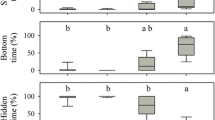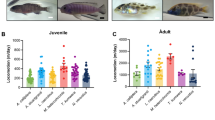Abstract
The persistence and precision of the endogenous, nocturnal, circadian locomotor rhythm of the sand-beach amphipod Talitrus saltator is characterised, and the influence of substrate availability, photoperiod, temperature and relative humidity as potential environmental synchronizers of the rhythm is assessed. Individual, cyclic light-dark and temperature regimes synchronize and modify the laboratory activity pattern, but substrate availability and relative humidity have no significant long-term effect. Under simulateneous experimental regimes simulating field conditions of photoperiod, temperature and relative humidity the rhythm is entrained solely by photoperiod. The implications are discussed in relation to field behaviour.
Similar content being viewed by others
Literature Cited
Aschoff, J.: Exogenous and endogenous components in circadian rhythms. Cold Spring Harb. Symp. quant. Biol. 25, 11–28 (1960)
Aschoff, J.: Circadian rhythms: influences of internal and external factors on the period measured in constant conditions. Z. Tierpsychol. 49, 225–249 (1979)
Atkinson, R. J. A. and E. Naylor: Activity rhythms in some burrowing decapods. Helgoländer wiss. Meeresunters. 24, 192–201 (1973)
Benson, J. A. and R. D. Lewis: An analysis of the activity rhythm of the sand beach amphipod, Talorchestia quoyana. J. comp. Physiol. 105, 339–352 (1976)
Bregazzi, P. K.: The effects of low temperature upon the locomotor activity rhythm of Talitrus saltator (Montagu) (Crustacea, Amphipoda). J. exp. Biol. 57, 393–399 (1972)
Bregazzi, P. K. and E. Naylor: The locomotor activity rhythm of Talitrus saltator (Montagu) (Crustacea, Amphipoda). J. exp. Biol. 57, 375–391 (1972)
Bünning, E.: Symptoms, problems, and common features of circadian rhythms in plants and animals. In: Proceedings of an International Symposium on Circadian Rhythmicity, pp 11–31. Ed. by J. F. Bierhuizen. Wageningen: Veenman & Zonen 1972
Chandrashekaran, M. K.: Phase shifts in the Drosophila pseudoobscura circadian rhythm evoked by temperature pulses of varying durations. J. interdiscip. Cycle Res. 5, 371–380 (1974)
Daan, S. and C. S. Pittendrigh: A functional analysis of circadian pacemakers in nocturnal rodents, III. Heavy water and constant light: homeostasis of frequency? J. comp. Physiol. 106, 267–290 (1976)
Duncan, D. B.: Multiple range and multiple F tests. Biometrics 11, 1–42 (1955)
Ercolini, A.: Sul ciclo normale di attivita in alcuni Talitridae littorali. Boll. Ist. Mus. Zool. Univ. Torino 6, 163–170 (1960)
Featherstone, D. W. and R. J. MacIntyre: Learning and daily activity in a sandhopper. Nature, Lond. 179, 381–382 (1957)
Geppetti, L. and L. Tongiorgi: Nocturnal migrations of Talitrus saltator (Montagu) (Crustacea: Amphipoda). Monitore zool. ital. (N.S.) 1, 37–40 (1967)
Imafuku, M.: On the nocturnal behaviour of Tylos granulatus Miers (Crustacea: Isopoda). Publs Seto mar. biol. Lab. 23, 299–340 (1976)
Naylor, E.: Temperature relationships of the locomotor rhythm of Carcinus. J. exp. Biol. 40, 669–679 (1963)
Palluault, M.: Notes écologiques sur le Talitrus saltator L. Archs Zool. exp. gén. 91, 105–129 (1954)
Palmer, J. D.: Comparative studies of circadian locomotory rhythms in four species of terrestrial crabs. Am. Midl. Nat. 85, 97–107 (1971)
Pardi, L. and M. Grassi: Experimental modification of direction-finding in Talitrus saltator (Montagu) and Talorchestia deshayesi (Aud) (Crustacea: Amphipoda). Experientia 11, 202–210 (1955)
Pittendrigh, C. S. and V. G. Bruce: Daily rhythms as coupled systems and their relation to thermoperiodism and photoperiodism. In: Photoperiodism and related phenomena in plants and animals, pp 475–505. Ed. by D. Withrow. Washington D.C.: American Association for the Advancement of Science 1959
Pittendrigh, C. S. and S. Daan: A functional analysis of circadian pacemakers in nocturnal rodents. I. The stability and lability of spontaneous frequency. J. comp. Physiol. 106, 223–252 (1976a)
Pittendrigh, C. S. and S. Daan: A functional analysis of circadian pacemakers in nocturnal rodents. IV. Entrainment: pacemaker as clock. J. comp. Physiol. 106, 291–331 (1976b)
Wildish, D. J.: Locomotory activity rhythms in some littoral Orchestia (Crustacea: Amphipoda). J. mar. biol. Ass. U.K. 50, 241–252 (1970)
Williams, J. A.: The effect of light on the locomotor rhythm and general biology of Talitrus saltator (Montagu), 258 pp. Ph. D. thesis, Liverpool University, Port Erin, Isle of Man 1976
Williams, J. A.: The annual pattern of reproduction of Talitrus saltator (Crustacea: Amphipoda: Talitridae). J. Zool., Lond. 184, 231–244 (1978)
Williams, J. A.: A semi-lunar rhythm of locomotor activity and moult synchrony in the sand-beach amphipod Talitrus saltator. Proc. 13th Eur. mar. Biol. Symp. 13, 407–414 (1979)
Williams, J. A.: The effect of dusk and dawn on the locomotor activity rhythm of Talitrus saltator (Crustacea: Amphipoda). J. exp. mar. Biol. Ecol. 42, 285–297 (1980)
Williams, J. A.: The light-response rhythm and seasonal entrainment of the endogenous circadian locomotor rhythm of Talitrus saltator (Crustacea: Amphipoda). J. mar. biol. Ass. U.K. (In press)
Williams, J. A. and E. Naylor: A procedure for the assessment of significance of rhythmicity in time-series data. Int. J. Chronobiol. 5, 435–444 (1978)
Williamson, D. I.: Studies on the biology of Talitridae (Crustacea: Amphipoda): effects of atmospheric humidity. J. mar. biol. Ass. U.K. 30, 73–90 (1951)
Author information
Authors and Affiliations
Additional information
Communicated by J. Mauchline, Oban
Rights and permissions
About this article
Cite this article
Williams, J.A. Environmental influence on the locomotor activity rhythm of Talitrus saltator (Crustacea: Amphipoda). Mar. Biol. 57, 7–16 (1980). https://doi.org/10.1007/BF00420962
Accepted:
Issue Date:
DOI: https://doi.org/10.1007/BF00420962




